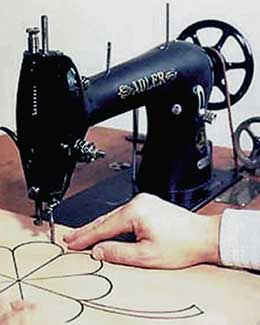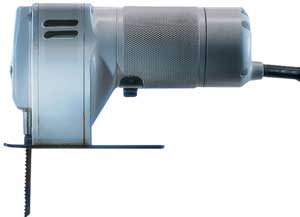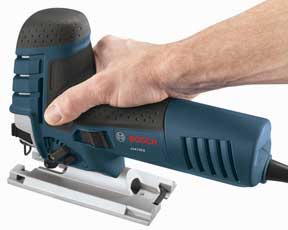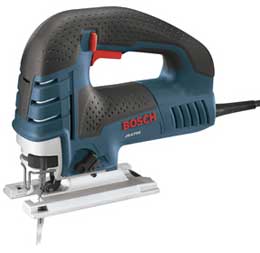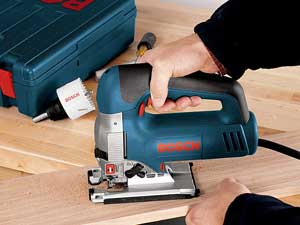
One of the first power tools many aspiring woodworkers buy is a jigsaw. It’s versatile, relatively inexpensive and, for the most part, pretty safe – even in the hands of a child. I started steering my first one through scraps of wood when I was in the third grade. And, I’m proud to say I’ve had no jigsaw calamities in the 30-some odd years since. You’ve probably had similar experiences with yours.
My nostalgia for jigsaws was rekindled recently when I participated in a big new product event held by Bosch at their U.S. headquarters in Mount Prospect, Illinois. The reason: Bosch is launching two new Swiss-made jigsaws in mid August: the JS470E Top-Handle and JS470EB Barrel Grip. Both of these 7-amp machines have electronic feedback circuitry, variable speed control, tool-free blade clamps and other smart features. Anticipated street prices will be in the mid $150s to $179, depending on the model. We’ll report more on them in future new product news, but suffice to say, they’ll benefit from Bosch’s extensive experience in jigsaw technology.
Which leads me to the point of this article. If you’re a jigsaw fan, you’re probably aware that Bosch has a reputation among woodworkers for building some of the best saws on the market. What you might not know is that Bosch was the very first power tool company to offer them, and they’ve been in the jigsaw business for more than 50 years. In fact, Bosch is the world’s leading manufacturer of jigsaws.
While at the new product event, I had the opportunity to speak with Jim Stevens, Bosch’s product manager of fine woodworking power tools, to learn more about the company’s jigsaw history and innovations in this tool category. It’s a rich legacy at that.
Jim explained that jigsaws were first developed in Switzerland by the company Scintilla AG in 1947. A year earlier, “Scintilla employee Albert Kaufmann had the bright idea of creating a small blade and attaching it to his wife’s sewing machine, and that was the beginning of the jigsaw…Scintilla was integrated into Bosch in 1954. Bosch felt that jigsaws were a good addition to their tool portfolio, having been in the rotary and demolition hammer business since the 1920s.
Since that time, Bosch has developed a full line of handheld and benchtop woodworking power tools, but their commitment to jigsaw innovation hasn’t waned. In fact, Jim reported that Bosch has led the industry with a number of important developments over the years. Bosch invented the old double-tang jigsaw blades. They also created the T-shank style blade that replaced it; it’s now the industry standard blade type. Bosch introduced bi-metal jigsaw blades back in 1981 and the first tool-less blade changing system a few years later (it’s still used on their 1584 and 1587 series saws). They’ve enhanced the blade-changing process further with the “One-Touch” system that ejects hot blades automatically so you don’t have to risk burning your fingers. Jim says the company’s Precision Control System, developed in 2004, virtually eliminates blade wander. If you’re an old hand with jigsaws, you know that a squirrely blade is the biggest drawback to using a jigsaw.
Here in the States, top-handled jigsaws continue to be the preferred tool, with the exception of New England users who curiously tend to prefer the barrel grip style. Among Bosch’s current saw models, the 1590EVS and 1591EVS are user favorites. A quick survey of Amazon’s buyer ratings confirms the popularity of the 1590: 142 out of 165 buyers give the tool a 5-star rating, and another 14 give it 4 stars.
American end-users generally hold jigsaws on top of a workpiece and cut in the horizontal position where gravity works in our favor, so the top handle is a comfortable configuration. But, I found it interesting to learn that the story is quite different in German-speaking and other Nordic countries.
“Many craftsman there hold their saws upside-down and use them as a sort of handheld scroll saw. They prefer the barrel-grip design because they can grip the saw closer to the bottom of the inverted saw and have better vertical stability of the tool and the work,” Jim says.
Now there’s a radical approach. I never imagined a jigsaw could be used that way, with the blade pointing up. I’ll probably leave that technique to our European comrades. In any case, whether you prefer to grip the handle or the barrel, cut with the blade stabbing down or jabbing up, Bosch plans to continue offering both tool styles when other jigsaw manufacturers are phasing the barrel grips out. Why? Jim explains that it all circles back around to the company’s heritage and dominance in this product area.
“Bosch is the leading power tool company in Europe. As for North America, people here also look to Bosch for ‘everything jigsaw’: tools, blades and more. We’ll continue to offer barrel-grip models so that we can meet the vast majority of jigsaw user needs.”
And that “vast majority” is a dizzying number indeed: in 2007, Bosch produced its 25 millionth jigsaw and 4 billionth saw blade. Quite a far cry from a cobbled sewing machine. Just imagine what Albert Kaufmann would think of that now
